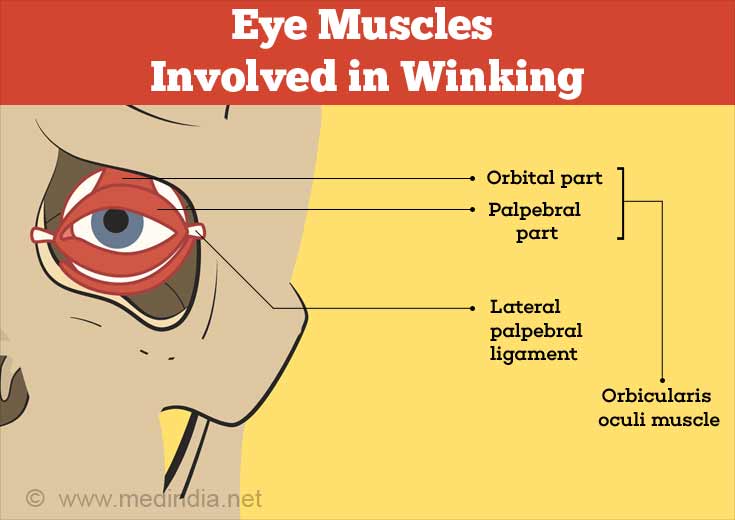- Anatomy of the Eye: American Association for Pediatric Ophthalmology and Strabismus - (http://www.aapos.org/terms/conditions/22)
- Diquot LG, Awad AH. Clinical features associated with the jaw winking syndrome. Am Orthopt J. 2001; 51: 125-31. DOI - (10.3368/aoj.51.1.125. PMID: 21149043)
- Wink: Cambridge Dictionary - (https://dictionary.cambridge.org/dictionary/english/wink)
- Marcus Gunn phenomenon - (https://rarediseases.info.nih.gov/diseases/6972/marcus-gunn-phenomenon)
What is Winking?
Winking is the rapid closing and opening of one eye to convey a message, suggestion, or signal. It is the most universal non-verbal communication in the form of a facial expression that has been reported since biblical times. Winking may be done as a joking spirit or might suggest a feeling of friendliness, affection, or greeting. In certain cases, depending upon the situation and associated body language, it might also signal a sexual interest.
Winking differs from blinking which involves rapid closing and opening of both eyes.
Anatomy & Physiology of the Extraocular Muscles of the Eye in Brief
The extraocular muscles numbering eight are the external muscles of the eye responsible for conscious movement of the eye in various directions. The basic eye movements include up and down, side to side, and eye rotation. The extraocular muscles are listed below:
- Superior oblique
- Inferior oblique
- Superior rectus
- Medial rectus
- Lateral rectus
- Inferior rectus
- Levator palpebrae superioris
- Orbicularis oculi

Eye Muscles Involved in Winking/Blinking
Muscles in the upper eyelid, that control the opening and closing of the eye are the orbicularis oculi and levator palpebrae superioris (LPS) muscle. The levator palpebrae muscle causes opening of the eye while the orbicularis oculi closes the eye. The Müller’s muscle in the upper eyelid and the inferior palpebral muscle in the lower eyelid cause widening the eyes. These muscles are responsible for blinking, squinting and winking. The inferior palpebral muscle is coordinated with the inferior rectus to pull down the lower lid when one looks down.

Prevalence of Winking
There are certain medical conditions like Marcus Gunn Jaw-winking Syndrome and hemifacial spasm, where winking occurs unintentionally. While the prevalence of the former is unknown, the approximate prevalence of the latter is 10 per 100,000 populations. However, this is a gross underestimation, since the majority of cases do not report to a health facility and therefore go undetected.
What are the Different Types of Winking?
The act of winking can have different connotations, that depend on the attitude and body language of the persons involved. Some of the different types of winking are briefly highlighted below:
Secretive Intention: A wink may mean that the winker is harboring a secret intention that he/she is reluctant to convey verbally to the receiver. Usually the receiver is unaware of the intentions of the winker. Besides the single wink, there may also be a double wink (wink wink) which can have an altogether different connotation.
Flirtatious Signal: A wink may indicate that a person is interested in flirting. This is the most common perception of a wink. Flirting may be harmless and done jokingly, or it may mean something deeper, including expression of a sexual desire, depending upon the situation and context.
Jocular Intent: This type of winking is seen in office parties or social gatherings. A particular person is targeted and teased by another person who winks jokingly. This is likely to hurt the receiver unless he/she takes it sportingly and in good humor.
Mutual Bonding: This particular type of wink conveys a sign of bonding or solidarity between two persons, even in seemingly difficult situations. This gesture has the effect of making the atmosphere lighter so that interaction can occur smoothly.
Mutual Trust: This type of wink conveys a feeling of mutual trust between two persons. The winking is usually accompanied by a sound made with the tongue and gums. It signifies emotional mutual agreement, dependency, and trust.
Medical Condition: Winking can be completely unintentional. This type of winking occurs when a person has an underlying pathological condition. For example, an undiagnosed neurological problem (Tourette syndrome) might be the cause of the winking.
Interesting Facts on Winking
- The word “wink” was first mentioned in the Holy Bible and it was linked to sin and sorrow. The Bible states “He that winketh with the eye causeth sorrow”. The act of winking has been linked to go against God.
- In China and in some parts of India that are conservative, winking is not taken sportingly. Rather, a wink is regarded to be an expression of sexual advance.
- During World War II, some Chinese soldiers were found to completely lack the ability to wink. They could not even close one eye to focus while firing a rifle.
- Although seemingly a simple act, winking requires the coordinated contraction/relaxation of as many as 49 muscles!
- In Africa, it is regarded as indecent for children to be present in a room full of adults. The children are winked-at to subtly indicate that they should leave the room.
- The act of winking or twitching of the eyelids is sometimes linked to superstition. In some countries like China, India, as well as others, left eye winking or right eye winking signifies an impending auspicious or inauspicious event, depending upon the winking eye involved.
Why Do We Wink?
This is a million-dollar question. Since the act of winking has existed since the advent of recorded history, it may have been instinctive, but its meaning and interpretation have changed with the advancement of time and societal norms. Even a few years back one could not have imagined winking using an emoji in a text message, which has now become the latest trend, particularly amongst teenagers.
Whatever the mode of winking, this form of non-verbal communication conveys certain emotions, feelings, or intentions. These vary with the context and culture, amongst other things. A few connotations of winking that could answer the above question are briefly listed below:
- Greeting or hello signal
- Flirtation signal
- Secretive shared knowledge signal
- Joking signal
- Comforting signal
- Expression of sympathy, solidarity or encouragement
- Discreet signal





